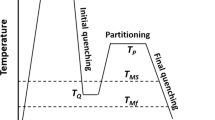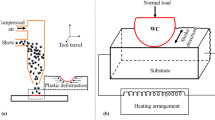Abstract
In this study, the influences of carburization (followed by quenching and low-temperature tempering) followed by shot peening on “apparent” fatigue limits of 20CrMnTi steel specimens were studied and quantitatively analyzed according to the microstructure changes, induced residual stress fields, and position of fatigue crack sources, as well as a micro-meso-process theory for fatigue crack initiation previously proposed by the authors (Ref 6–8). The experimental results show that, although the hardness of the surface layer of carburized specimens is much higher than that of the pseudo-carburized specimens, the improvement effect of carburization on the apparent fatigue limits of specimens is uncertain. It should be related to the possible formation of nonmartensitic microstructure in the surface layer of carburized specimen. After the shot peening, the fatigue limit of specimens was improved and rose to a level about 40% higher than that of the pseudo-carburized specimens. Scanning electron microscopy fractographic analyses show that the fatigue sources, which indicate the weakest link of specimens, in pseudo-carburized and ascarburized specimens are all located at the surface, while after shot-peening, they appear in the interior beneath the hardened layer.
Similar content being viewed by others
References
Y. Gao, “Quantitative Study on Influence of Chemical Heat Treatment on Apparent Fatigue Limit of Structural Steel Specimens,” Master’s Thesis, Yanshan University, Qinhuangdao, 2000 (in Chinese)
Y. Gao and M. Yao, Quantitative Study on Influence of Chemical Heat Treatment on Apparent Fatigue Limit of 40Cr Steel, J. Aeronautical Mater., Vol 22 (No. 4), 2002, p 21–25 (in Chinese)
G.E. Dieter, Mechanical Metallurgy, 2nd ed., McGraw-Hill, Inc., 1976, p 411–412.
D. Zhang and J. He, Residual Stress Analysis by X-ray Diffraction and Its Function, Xi’an Jiaotong University Press, Xh’an, People’s Republic of China, 1999, p 66–73 (in Chinese)
J. Li and M. Yao, Tensile Residual Stress Field Induced by Shot Peening and Internal Fatigue Limit of Materials, Acta Aeronaut. Astronaut. Sin., Vol 11A, 1990, p 511–519 (in Chinese).
Y. Gao, M. Yao, and J. Li, An Analysis of Residual Stress Fields Caused by Shot Peening, Metall. Mater. Trans. A, Vol 33 (No. 6), 2002, p 1775–1778
Y-K. Gao, F. Lu, Y-F. Yin, and M. Yao, Effect of Shot Peening on Fatigue Property of 0Cr13Ni8Mo2Al Steel, Mater. Sci. Technol., Vol 19 (No. 3), 2003, p 372–374
Y. Gao, M. Yao, P. Shao, and Y. Zhao, Another Mechanism for Fatigue Strength Improvement of Metallic Parts by Shot Peening, J. Mater. Eng. Perf., Vol 12 (No. 5), 2003, p 507–511
Author information
Authors and Affiliations
Rights and permissions
About this article
Cite this article
Gao, Yk., Lu, F., Wu, Xr. et al. Influence of carburization followed by shot peening on fatigue property of 20CrMnTi steel. J. of Materi Eng and Perform 14, 591–595 (2005). https://doi.org/10.1361/105994905X64495
Received:
Revised:
Published:
Issue Date:
DOI: https://doi.org/10.1361/105994905X64495




